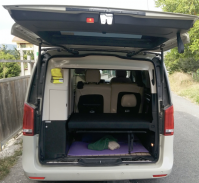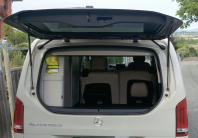M
MartinMere
Guest User
An update after 3400km, made up of a real mix of daily driving, A-roads, motorways and even some not so sensible dozen or so km on dusty, bumpy tracks in search of dark skies to pursue my astronomy obsession....
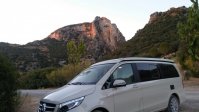
After 4 nights sleeping in the lower bed I can confirm my initial impression that the bed is perfectly flat and quite firm without a topper (which works well for me). The roll-down blinds don't entirely cover the windows, which at first seems odd, but the windows (which are tinted as standard here) have a thick dark (actually opaque) tint around the edge so in fact there is almost no light ingress. I guess the camper (or underlying vehicle) is designed for sunny climes. I've been happily working in the back of the van when parked up in full sun with the door and kitchen window open in temperatures of 35C and can attest to the practicality and effectiveness of the tinted windows over here at least! The front part is covered by curtains which are affixed with suckers to the side windows and elastic that stretches over the sun visors. I find it a bit of a pain fixing the front curtain so my plan is to hang curtain wire from some pre-existing convenient supports where the roof bed reaches the cab, and install some normal drawable curtains at that point (essentially just behind the front seats).
The opening rear window is a very worthwhile option as it allows the boot space to be divided into two and means the amount of ventilation can be controlled (either opening the entire tailgate or just the window). It keeps all the stuff below the lower bed out of sight and is just a lot more flexible all round. It can be opened remotely with the key fob, so on waking up in the morning it is a cinch to enjoy the fresh air and a view.
The kitchen area is split into 3 separately raisable worktops which leads to lots of options for food preparation. The sink is quite small but adequate for washing up. The burners are powerful and can brew up coffee on the lowest setting in a minute or so.
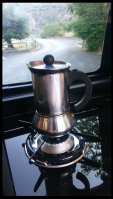
The floor is like a very hard lino and being completely smooth is easy to keep clean (esp. with a dog). The downside for the dog is that is it hard for the poor mutt to get any purchase... It is possible for those that don't like the yacht-effect flooring to specify a Cali-like grey textured floor, with a commensurate reduction in cost. We looked at one but it does show the dirt immediately you step on it and seems like more of a hassle to clean (being textured).
Another point raised above is the rear top storage. Actually, it is quite large and stuff doesn't fall out. I don't know how it compares to a Cali but for storing all the sheets and towels it is more than adequate. Actually, the amount of storage in general seems excessive to me. We have trouble filling it all.
Re the air-con issues that I mentioned in an earlier post, it turns out that the default in the Marco Polo is to have just circulating air in the rear part. It is important to switch this off on a hot day (it defaults to on at the start of each trip). On a really hot day, moving the rear bench forward a bit allows rear passengers to take advantage of the strong cooled airflow from the large vent between, and to the rear of, the front seats.
The engine is settling in nicely and we managed an average of 42 mpg at a steady 75 mph over a 950 km distance yesterday, fully loaded. The best we've had so far on a 92 km trip on a combination of fairly empty/flat A-roads plus driving through the centre of a major city (Jerez) was just over 54 mpg, quite surprising to me. These figures, along with the easy of handling, I think make the Marco Polo worth considering for anyone wanting both a daily driver and a camper van.
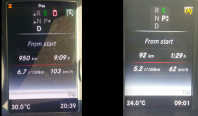
Maybe we got lucky, but the only failing so far has been the white plastic filler piece in one of the USB ports that has snapped off...
One thing that takes some getting used to is lowering the roof. Raising it is a matter of releasing a couple of catches and within 2 seconds it is up via a gentle push. But lowering it involves pushing at a point helpfully marked 'PUSH' in a large font, the purpose of which is to re-align the tubes on the RHS (just visible in this shot) which act as a 'stop' when the roof is up. Pushing has to be just right; too much and the tubes won't telescopically collapse one within the other.
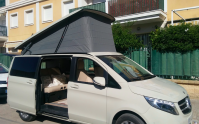
Talking of the roof, at first we couldn't work out why it looks so dark outside and yet so light inside, but it turns out to be a two layer affair.
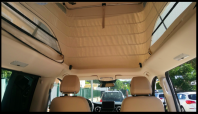
Just to end: the dealers (Gazpi in Pamplona) couldn't have been more helpful throughout and if anyone is in the position of wanting to buy over here I can't recommend them enough.
Martin

After 4 nights sleeping in the lower bed I can confirm my initial impression that the bed is perfectly flat and quite firm without a topper (which works well for me). The roll-down blinds don't entirely cover the windows, which at first seems odd, but the windows (which are tinted as standard here) have a thick dark (actually opaque) tint around the edge so in fact there is almost no light ingress. I guess the camper (or underlying vehicle) is designed for sunny climes. I've been happily working in the back of the van when parked up in full sun with the door and kitchen window open in temperatures of 35C and can attest to the practicality and effectiveness of the tinted windows over here at least! The front part is covered by curtains which are affixed with suckers to the side windows and elastic that stretches over the sun visors. I find it a bit of a pain fixing the front curtain so my plan is to hang curtain wire from some pre-existing convenient supports where the roof bed reaches the cab, and install some normal drawable curtains at that point (essentially just behind the front seats).
The opening rear window is a very worthwhile option as it allows the boot space to be divided into two and means the amount of ventilation can be controlled (either opening the entire tailgate or just the window). It keeps all the stuff below the lower bed out of sight and is just a lot more flexible all round. It can be opened remotely with the key fob, so on waking up in the morning it is a cinch to enjoy the fresh air and a view.
The kitchen area is split into 3 separately raisable worktops which leads to lots of options for food preparation. The sink is quite small but adequate for washing up. The burners are powerful and can brew up coffee on the lowest setting in a minute or so.

The floor is like a very hard lino and being completely smooth is easy to keep clean (esp. with a dog). The downside for the dog is that is it hard for the poor mutt to get any purchase... It is possible for those that don't like the yacht-effect flooring to specify a Cali-like grey textured floor, with a commensurate reduction in cost. We looked at one but it does show the dirt immediately you step on it and seems like more of a hassle to clean (being textured).
Another point raised above is the rear top storage. Actually, it is quite large and stuff doesn't fall out. I don't know how it compares to a Cali but for storing all the sheets and towels it is more than adequate. Actually, the amount of storage in general seems excessive to me. We have trouble filling it all.
Re the air-con issues that I mentioned in an earlier post, it turns out that the default in the Marco Polo is to have just circulating air in the rear part. It is important to switch this off on a hot day (it defaults to on at the start of each trip). On a really hot day, moving the rear bench forward a bit allows rear passengers to take advantage of the strong cooled airflow from the large vent between, and to the rear of, the front seats.
The engine is settling in nicely and we managed an average of 42 mpg at a steady 75 mph over a 950 km distance yesterday, fully loaded. The best we've had so far on a 92 km trip on a combination of fairly empty/flat A-roads plus driving through the centre of a major city (Jerez) was just over 54 mpg, quite surprising to me. These figures, along with the easy of handling, I think make the Marco Polo worth considering for anyone wanting both a daily driver and a camper van.

Maybe we got lucky, but the only failing so far has been the white plastic filler piece in one of the USB ports that has snapped off...
One thing that takes some getting used to is lowering the roof. Raising it is a matter of releasing a couple of catches and within 2 seconds it is up via a gentle push. But lowering it involves pushing at a point helpfully marked 'PUSH' in a large font, the purpose of which is to re-align the tubes on the RHS (just visible in this shot) which act as a 'stop' when the roof is up. Pushing has to be just right; too much and the tubes won't telescopically collapse one within the other.

Talking of the roof, at first we couldn't work out why it looks so dark outside and yet so light inside, but it turns out to be a two layer affair.

Just to end: the dealers (Gazpi in Pamplona) couldn't have been more helpful throughout and if anyone is in the position of wanting to buy over here I can't recommend them enough.
Martin






